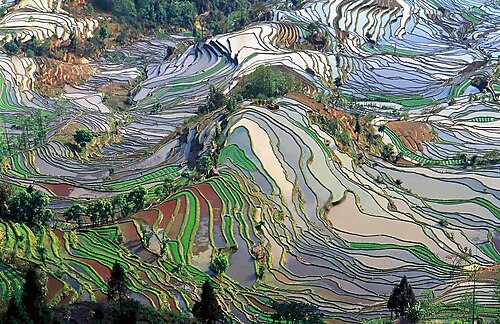| Rice | |
|---|---|
 Japonica plant | |
| Source plant(s) | Oryza sativa , mostly O. s. cv. japonica |
| Part(s) of plant | Seed |
| Geographic origin | Yangtze River basin |
| Active ingredients | Possible wild gathering 10kya, predomestication 8kya, domestication 7,500kya [1] |
| Uses | Human dietary staple |
| Main producers | Yunnan, Hunan, Heilongjiang, Jiangxi, Hubei, Anhui, Jiangsu [2] |

Rice production in China is the amount of rice planted, grown, and harvested for consumption in the mainland of China.
Contents
- History
- Wild rice and its domestication
- Rice cultivation
- Planting techniques
- Rice variants
- Wild rice
- Chinese cultivated varieties
- Rice breeding
- Subspecies by region
- Japonica
- Indica
- Subspecies and their growing regions
- Geographical setting
- Growing regions
- Climate, growing periods, and soils
- Growing seasons
- Production
- Processes
- Quality
- Changes to planting areas
- Exports
- Challenges
- Climate change
- Overuse of fertilisers
- Overuse of pesticides
- Future development
- Germaplasms and genetic diversity
- Integrated cultivation systems
- Water usage
- Consumption
- Cooked rice
- Noodles
- Glutinous Rice and milled rice delicacies
- Alcoholic beverages
- Rice bran
- References
It is an important part of the national economy, [3] where it is the world's second-largest producer of rice as of 2025. [4] It produces the highest rice yields in Asia, at 6.5 metric tons per hectare (2.6 long ton/acre; 2.9 short ton/acre). [5] Rice is produced throughout the nation and is believed to have been first domesticated in the surrounding regions of the Yangtze River and the Yunnan-Guizhou highlands of Southern China. Rice is believed to have been first cultivated around the Yangtze River Valley and Yellow River 11,000 years ago, and found upon clustering in the middle of the Yangtze River in the provinces of Hubei and Hunan in central China [6] according to archaeological records. Rice production in China uses techniques, such as turning soil into mud to prevent water loss, as well as seed transplantation.
The main variants of rice produced and grown in China encapsulates wild rice species of O. Mereriana, O. Officinalis, and O. Rufipogon and the main Chinese cultivated rice varieties are indica and japonica subspecies, [7] with ongoing developments of rice breeding in hybrid rice established by the Ministry of Agriculture in China.
The subspecies of the Indica and Japonica rice are produced in different, and some in overlapping, regions across China with the hybrid rice predominantly growing in the region of Central China.
There are many geographical regions across China for rice production. The geographical setting in the rice production regions across China highlights different climates (subtropical, cold, and dry), growing periods, and soils which is what makes the rice varieties distinct from one another. The geographical setting is what delineates the different planting and harvesting seasons of rice variants in the regions.
Rice production in China is labour-intensive, and is dependent on a variety of cropping and planting methods. The processes of production in cropping systems vary across the regions of China due to the differences in climate in each growing region. The predominant processes of rice production in planting methods that are in use in China include transplanting, manual transplanting, mechanical transplanting, throwing seeding, direct seeding, as well as rice ratooning. Under differences and changes in the selection of rice varieties and cultivation techniques under various planting methods, this highlights the differences in terms of rice quality. Due to changes in recent decades in all aspects, this has led to the changes in planting areas across China for rice production.
In terms of exports, China has exported 4.56% of the world's rice in 2019, with a value of US$1.13 billion. [8] As of 2020/2021, it is the sixth principal rice exporter in the world behind India, Vietnam, Thailand, Pakistan, and the United States. [9]
The rice production in China over recent years has faced challenges. These challenges encapsulate climate change that has brought increased frequencies of natural disasters, overuse of fertilisers that leads to a decline in the fertility of the land, as well as overuse of pesticides that promotes changes in biodiversity leading to increased pest outbreaks.
The future of rice production in China is one that encapsulates elite germaplasm, genetic diversity, and the super rice breeding programs to promote tolerance to the current challenges. The future prospects of integrated rice cultivation systems are to be further developed in assistance of current agricultural systems and databases to manage current challenges. Moreover, lowering water-usage is also a future prospect to be delved into.
Rice is highly prized by consumers as a food grain, making it a staple food for two-thirds of the nation. [10] Produced rice grains that have numerous flavours, textures, and grains, each with unique differentiating forms and distinct qualities, can be made into a variety of foods that are prominent in China. Out of all, one type that is renowned across the world is cooked rice, which can encapsulate both rice porridge and fried rice. Rice grained and ground can be made into noodles. Glutinous sticky rice is also a form of rice that can be turned into a variety of dishes and desserts, as well as including alcoholic beverages and rice brans.












